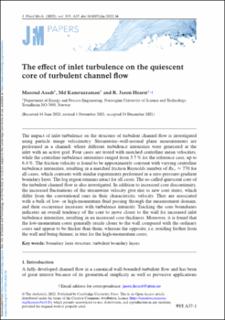| dc.contributor.author | Asadi, Masoud | |
| dc.contributor.author | Kamruzzaman, Md | |
| dc.contributor.author | Hearst, Robert Jason | |
| dc.date.accessioned | 2022-02-04T08:20:52Z | |
| dc.date.available | 2022-02-04T08:20:52Z | |
| dc.date.created | 2022-02-03T14:32:52Z | |
| dc.date.issued | 2022 | |
| dc.identifier.issn | 0022-1120 | |
| dc.identifier.uri | https://hdl.handle.net/11250/2977041 | |
| dc.description.abstract | The impact of inlet turbulence on the structure of turbulent channel flow is investigated using particle image velocimetry. Streamwise–wall-normal plane measurements are performed in a channel, where different turbulence intensities were generated at the inlet with an active grid. Four cases are tested with matched centreline mean velocities, while the centreline turbulence intensities ranged from 3.7 % for the reference case, up to 6.4 %. The friction velocity is found to be approximately constant with varying centreline turbulence intensities, resulting in a matched friction Reynolds number of Reτ≈770 for all cases, which contrasts with similar experiments performed in a zero-pressure-gradient boundary layer. The log region remains intact for all cases. The so-called quiescent core of the turbulent channel flow is also investigated. In addition to increased core discontinuity, the increased fluctuations of the streamwise velocity give rise to new core states, which differ from the conventional ones in their characteristic velocity. They are associated with a bulk of low- or high-momentum fluid passing through the measurement domain, and their occurrence increases with turbulence intensity. Tracking the core boundaries indicates an overall tendency of the core to move closer to the wall for increased inlet turbulence intensities, resulting in an increased core thickness. Moreover, it is found that the low-momentum cores generally reside closer to the wall compared with the ordinary cores and appear to be thicker than them, whereas the opposite, i.e. residing farther from the wall and being thinner, is true for the high-momentum cores. | en_US |
| dc.language.iso | eng | en_US |
| dc.publisher | Cambridge University Press | en_US |
| dc.rights | Navngivelse 4.0 Internasjonal | * |
| dc.rights.uri | http://creativecommons.org/licenses/by/4.0/deed.no | * |
| dc.title | The effect of inlet turbulence on the quiescent core of turbulent channel flow | en_US |
| dc.type | Peer reviewed | en_US |
| dc.type | Journal article | en_US |
| dc.description.version | publishedVersion | en_US |
| dc.source.volume | 935 | en_US |
| dc.source.journal | Journal of Fluid Mechanics | en_US |
| dc.identifier.doi | 10.1017/jfm.2022.36 | |
| dc.identifier.cristin | 1997441 | |
| dc.relation.project | Norges forskningsråd: 288046 | en_US |
| dc.relation.project | Norges forskningsråd: 280578 | en_US |
| cristin.ispublished | true | |
| cristin.fulltext | original | |
| cristin.qualitycode | 2 | |

